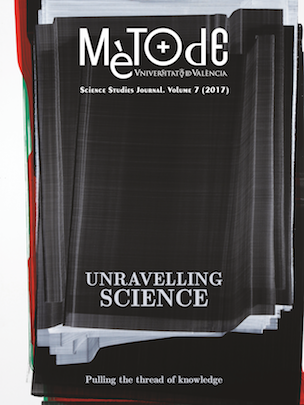Ghost particles in the universe: Neutrinos in astrophysics and cosmology
DOI:
https://doi.org/10.7203/metode.7.8507Keywords:
neutrinos, dark matter, supernova, flavor oscillations, astroparticle physics Abstract
Abstract
Neutrinos are nearly massless and very difficult to detect because they interact so very weakly. Sixty years after seeing the first of these «ghost particles» we know a lot about their properties. Today, observing them in nuclear reactors, the Sun, the Earth’s crust and atmosphere, and at high energies from distant cosmic sources is almost a routine task – they have become unique astrophysical messengers. They are important for a number of aspects: neutrinos shape some of the most dramatic astrophysical phenomena in the form of stellar-collapse supernova explosions, they may have created the excess of matter over antimatter in the universe, and neutrino-like «weakly interacting massive particles» may well account for the dark matter of the universe.
 Downloads
Downloads
 References
References
Bertone, G. (Ed.). (2010). Particle dark matter: Observations, models and searches. Cambridge: University Press.
Bilenky, S. (2010). Introduction to the physics of massive and mixed neutrinos. Lecture Notes in Physics, 817, 1–255. doi: 10.1007/978-3-642-14043-3
Buchmüller, W., Di Bari, P., & Plümacher, M. (2005). Leptogenesis for pedestrians. Annals of Physics, 315, 305–351. doi: 10.1016/j.aop.2004.02.003
Dell’Oro, S., Marcocci, S., Viel, M., & Vissani, F. (2016). Neutrinoless double beta decay: 2015 Review. Advances in High Energy Physics, 2162659. doi: 10.1155/2016/2162659
UNE Collaboration. (2015). Long-baseline neutrino facility (LBNF) and deep underground neutrino experiment (DUNE). Conceptual design report. Volume 2: The Physics Program for DUNE at LBNF. Retrieved from http://arXiv.org/abs/1512.06148
Gariazzo, S., Giunti, C., & Laveder, M. (2016). Neutrino unbound. Retrieved from http://www.nu.to.infn.it/
Horowitz, C. J., Coakley, K. J., & McKinsey, D. N. (2003). Supernova observation via neutrino-nucleus elastic scattering in the CLEAN detector. Physical Review D, 68, 023005. doi: 10.1103/PhysRevD.68.023005
Hyper-Kamiokande Proto-Collaboration. (2015). Physics potential of a long-baseline neutrino oscillation experiment using a J-PARC neutrino beam and Hyper-Kamiokande. Progress of Theoretical and Experimental Physics, 053C02. doi: 10.1093/ptep/ptv061
IceCube Collaboration. (2013). First observation of PeV-energy neutrinos with IceCube. Physical Review Letters, 111, 021103. doi: 10.1103/PhysRevLett.111.021103
Janka, H.-T. (2012). Explosion mechanisms of core-collapse supernovae. Annual Review of Nuclear and Particle Science, 62, 407–451. doi: 10.1146/annurev-nucl-102711-094901
JUNO Collaboration. (2016). Neutrino physics with JUNO. Journal of Physics G: Nuclear and Particle Physics, 43, 030401. doi: 10.1088/0954-3899/43/3/030401
Koshiba, M. (1992). Observational neutrino astrophysics. Physics Reports, 220, 229–381. doi: 10.1016/0370-1573(92)90083-C
Mirizzi, A., Tamborra, I., Janka, H.-T., Saviano, N., Scholberg, K., Bollig, R., … Chakraborty, S. (2016). Supernova neutrinos: Production, oscillations and detection. La Rivista del Nuovo Cimento, 39, 1–112. doi: 10.1393/ncr/i2016-10120-8
Scholberg, K. (2012). Supernova neutrino detection. Annual Review of Nuclear and Particle Science, 62, 81–103. doi: 10.1146/annurev-nucl-102711-095006
Villaescusa-Navarro, F., Bull, P., & Viel, M. (2015). Weighing neutrinos with cosmic neutral hydrogen. Astrophysical Journal, 814, 146–165. doi: 10.1088/0004-637X/814/2/146
Downloads
Published
How to Cite
-
Abstract973
-
PDF343
Issue
Section
License
![]()
All the documents in the OJS platform are open access and property of their respective authors.
Authors publishing in the journal agree to the following terms:
- Authors keep the rights and guarantee Metode Science Studies Journal the right to be the first publication of the document, licensed under a Creative Commons Attribution-NonCommercial-NoDerivatives 4.0 International License that allows others to share the work with an acknowledgement of authorship and publication in the journal.
- Authors are allowed and encouraged to spread their work through electronic means using personal or institutional websites (institutional open archives, personal websites or professional and academic networks profiles) once the text has been published.





